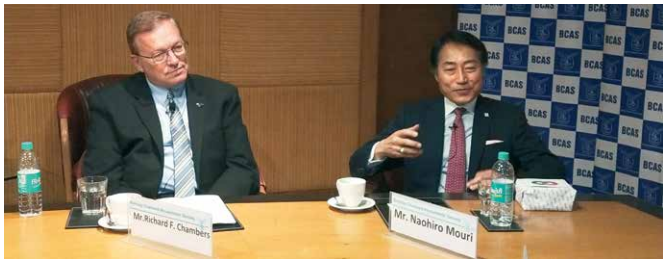India’s
policy-makers introduced the GST law with the objective of removing the
cascading effect of taxes and replacing it with a single value-added tax across
the country. The Statement of Objects and Reasons for the Constitutional (One
Hundred and Twenty Second Amendment) Bill, 2014 and the memorandum introducing
the GST Bill(s) had as their objective a seamless transfer of Input Tax Credit
along the value chain of a product and consequently to reduce the cost of
production and inflation in the economy.
Effective
1st July, 2017, the key compliance for a taxpayer was to prepare and
file his Transition Forms (in Form Tran-1 and / or Tran-2).The transition
credit became a critical entry step for taxpayers to avail the benefit of GST
and commence their journey into an idealistic value-added tax system. Many
large enterprises had blocked their working capital in such taxes and were
seeking early utilisation of their credit against their output taxes. Despite
the lack of robust legal and technical support from the regulatory authorities,
most business houses succeeded with the advice of tax practitioners, but there
was a set of businesses (a small percentage of the total GST registrations) who
struggled to perform their transition obligations. The eligibility or
ineligibility of transition credit is not the subject of discussion of this
article – and nobody denies a rightful claimant this transition credit; what is
under debate is the strict time limit imposed by the Revenue authorities in
complying with the transition credit formalities.
A
significant number of taxpayers failed to exercise their transitional credit
rights. The reasons were varied and we may categorise the taxpayers into broad
categories of those (a) unaware of the entitlement of transition credit (MSMEs,
rural and semi-urban entities, etc.); (b) aware but clueless about filling up
the transition forms due to lack of appropriate advisers and regulatory
support; (c) facing technical challenges (at their end or at the GSTN portal
end); and (d) those who genuinely missed the bus due to multiple extensions,
the peculiar due date of 27th December, 2017 and so on.
Thus,
taxpayers are in a tussle before the Courts to resolve this deadlock where they
are pleading for condonation but the Revenue is contending that 180 days was
sufficient time and no leniency is to be given to taxpayers on this subject.
Revenue also claims that the plea of technical difficulties is a mere alibi and
the sole proof of a genuine attempt to file a transition is the GSTN system log
and nothing else.
BACKGROUND TO TRANSITION COMPLIANCE
Section
140 provided for the claim of transition credit under multiple scenarios.
Unlike the time limits prescribed for availing GST Input Tax Credit (ITC) u/s
16, there was a clear absence of any time limit under the primary enactment.
Rule 117 of the CGST Rules notified that the declaration ought to be filed
electronically within 90 days from the appointed date. The proviso provided for an extension by the
Commissioner by another 90 days based on the recommendations of the GST
Council. Accordingly, the initial time limit stood at 28th September,
2017 which was subsequently extended by Order Nos. 3/2017, 7/2017 and 9/2017 to
31st October, 30th November and finally to 27th
December, 2017. In fact, 27th December, 2017 was the last
permissible date for extension of filing Tran-1 under Rule 117 of the CGST
Rules. The said orders were issued by the Commissioner of GST in terms of
powers exercised under Rule 117 read with section 168 of the CGST Act. The
transition forms were disabled on the GSTN portal immediately after (on 28th
December, 2017) and hence taxpayers who could not file their returns were
not permitted to make any electronic submission of their transition data.
Apart from
the taxpayers in general, to give effect to Court directions (discussed later),
Rule 117(1A) was introduced which provided case-specific extensions to taxpayers
who proved their bona fides of facing
technical difficulties. The overall time limit of Rule 117(1A) was frequently
extended until 31st March, 2020 and effectively stood extended up to
31st August, 2020 (under the general Covid Notifications).
BONE OF CONTENTION
The
primary grievance of taxpayers on the legal front was that the time limit
specified in Rule 117 was beyond the powers delegated to the Central Government
u/s 140 of the CGST Act. The section provided for prescription of rules for the
limited purpose of defining the manner or form in which the declaration u/s 140
was to be made by the taxpayers. The section did not delegate the powers of
fixing or extending time limits for filing the Transition declaration. Revenue,
on the other hand, considered section 164 as empowering them to make rules for
any purpose of the Act. The matter was challenged in multiple High Courts and
contrary rulings have been delivered (discussed later). Revenue authorities
quickly recognised the deficiency in the provisions of section 140 and
introduced a retrospective amendment vide
Finance Act, 2020 empowering the Central Government to validate the time limits
specified in Rule 117. Interestingly, the amendment was brought in to validate
a time limit which had already expired / lost its utility and is certainly
questionable before the Courts.
The other
grievance of taxpayers was that the multiple extensions were on account of a
lack of readiness of the GST portal and sufficient time was not provided for
filing the Transition returns. Those taxpayers who had the available data were
facing technical difficulties either with the web portal or the Transition
form. Revenue acknowledged that taxpayers faced technical difficulties and
quickly formed an IT Grievance Redressal Committee (ITGRC) on the directions of
the High Courts of Allahabad and Bombay.
Revenue
issued Circular No. 39/13/2018-GST dated 3rd April, 2018 setting up
a committee on the basis of the approval granted by the GST Council vide its 26th meeting held on 10th March,
2018. The Circular defined a very narrow entry point to approach the ITGRC,
i.e.,
- Where
the taxpayer has made a bona fide
attempt to file the Tran return and recorded by the system logs maintained by
GSTN;
- No
amendment is permissible to the data already available in the GSTN servers and
ITGRC cannot be used as a forum to revise Transition claim data;
- Field
formations were directed to verify the data and collection of information at
the time of seeking special permission to open the GSTN portal;
- ITGRC
would approve the opening of the GST portal for the specified taxpayers who met
the criteria set forth by the ITGRC and established technical difficulties
conclusively.
Seeing
this ray of hope, many taxpayers approached the ITGRC with their grievances and
sought filing of the Tran returns. But much to their disappointed, many
taxpayers failed to meet the stringent criteria set forth by the ITGRC and once
again knocked at the door of the Courts for justice. The following applications
were rejected by the ITGRC:
- Lack
of digital evidence like screenshots, help-desk correspondence, etc.;
- Unawareness
about the due date;
- Lack
of knowledge of computer systems;
- Mistakes
committed while filing online; and
- Ignorance
with the hope that the due date would be extended,
etc.
The tussle
regarding Transition credit is now before several Courts and case-specific
decisions are being delivered on this front to resolve the issue. The decisions
would be clubbed based on the similarities of the issues and the decision
rendered.
DIVERGENT VIEWS OF THE COURT
Type 1
decisions: Recognised that transition credit is a
vested right and procedural lapses cannot submerge this right.
In Siddharth Enterprises (2019) (9) TMI 319,
the Gujarat High Court was examining a matter where the taxpayer did not file
the transition return due to technical challenges and challenged the time limit
provisions under Rule 117 as being ultra vires
the statute. The taxpayer argued that the intention of the Government is not to
collect tax twice on the same goods; section 140(3) grants a substantive right
which cannot be curtailed by procedural lapses; right accrued / vested under
the existing law and is saved under GST; right of credit is a constitutional
right; doctrine of legitimate expectation is applicable to such credit. The
Court laid down a very elaborate order and affirmed that credit is due to the
taxpayer in terms of section 140. The key findings of the Court were as
follows:
- Credit
legally accrued under the erstwhile laws is a vested right and cannot be taken
away by virtue of Rule 117 with retrospective effect on failure to file the
Transition form. The provision of credit is as good as tax paid and such right
cannot be offended on failure to file the form;
- The
denial of transition credit is against the policy of avoiding the cascading
effect of taxes which has been explicitly set out in the Statement of Objects
and Reasons of the Constitutional Amendment bill;
- Section
16 grants time until September, 2018 to claim the ITC while the transition
credit has been limited until 27th December, 2017 which is
discriminatory and without any rationale;
- The
doctrine of legitimate expectation mandates that a person would have a
legitimate expectation to be treated by any administrative authority in a
particular manner based on the representations or promises made by such
authority. The vested right of ITC cannot be withdrawn after compliance of
conditions under the erstwhile laws;
- Input
Tax Credit is a property right in terms of Article 300A and cannot be denied on
procedural lapses.
These
views were subsequently adopted in Heritage
Lifestyles & Developers Private Limited (2020) (11) TMI 236 wherein
the coordinate bench of the Bombay High Court observed the divergent decision
of NELCO (discussed below) and yet held
that the substantive right of credit cannot be denied on procedural grounds and
technicalities cannot hinder substantial justice.
Type 2
decisions: Input Tax Credit is a concession and not
a right and hence prescription under rule 117 is valid law which mandates
strict compliance.
In NELCO Ltd. (2020) (3) TMI 1087, the
Bombay High Court examined the challenge to the time limit under Rule 117. The
taxpayer had attempted filing the Transition return, submitted their browsing
history and communicated their grievance via email multiple times but failed to
receive a suitable response. The line of argument adopted in this case was more
on the vires of Rule 117 and the phrase
‘technical difficulties’ in 117(1A). The taxpayer contended that the said
phrase would refer to difficulties both at the taxpayer’s end as well as the
GSTN end. Revenue contended that presumption of legality of law and subordinate
legislation cannot be negated until it is arbitrary or unreasonable. Section
164(2) has granted a general rule-making authority to the Government for the
implementation of the Act which includes, amongst others, the right to specify
the time limit for filing of transition declarations. The Court finally upheld
Revenue’s contentions as follows:
- Section
164 grants rule-making powers of the widest amplitude and is sufficient to
validate Rule 117. It does not rule contrary to the parent enactment. Once the
rule is held to be valid, the time limit prescribed therein operates strictly;
- Rule
117(1A) has been inserted to address genuine technical difficulties and
provides for a uniform and technically capable criterion for ascertaining the
claim and the taxpayer should follow this process;
- Input
Tax Credit being a concession should be utilised in a time-bound manner;
- ‘Technical
difficulty’ should be understood as those at the GSTN server-end and not
elsewhere. When multiple taxpayers succeeded in filing the form, there was no
reason for citing technical reasons for non-filing. The system log is an
unquestionable criterion for ascertaining the genuineness of the claim of
technical difficulty and the absence of such a criterion may make the
examination subjective.
These
views were subsequently followed in P.R.
Mani Electronics (2020) (7) TMI 443.
Type 3
decisions: Recognised technical glitches at the
taxpayer’s end and granted a time limit of three years from introduction of GST
to claim the transition credit.
In Brand Equity (2020) (7) TMI 443 which
included many other matters as a batch, the claim of transition credit could
not be complied with due to various reasons (such as a genuine lapse, system
error, preoccupation, etc.). In such cases, taxpayers admittedly did not have
any evidence of a GSTN error and Courts were examining the cases on meritorious
grounds rather than technical grounds. Taxpayers argued that GST being a new
levy suffering from technical glitches, the procedures should be applied
liberally. The Courts observed as follows:
- Evidently,
the GSTN portal was riddled with shortcomings and inadequacies. The online
portal should be able to perform all functions of the law with all
flexibilities / options. The Government cannot be insensitive to the
difficulties faced by trade;
- Credit
duly accumulated under the erstwhile laws are vested rights and in the absence
of a mechanism to claim refund under the said laws, taxpayers rightly entitled
to migrate this credit into GST;
- There
is nothing sacrosanct in the time limit of 90 days since it has been extended
multiple times on account of an inefficient network. The Act does not specify a
strict time limit for claiming the transition credit;
- The
classification of extending the time limit to specified taxpayers faced
challenges at the GSTN and not extending to taxpayers in general is arbitrary
without reasonable basis;
- Government
cannot adopt different standards for itself and for the taxpayers when both
were facing technical issues at their respective ends;
- Taxpayers
cannot be robbed of their vested rights within 90 days when civil laws grant
the right for three years;
- Rule 117 is directory and cannot
take away a substantive right. The phrase ‘in the manner prescribed’ can be
prescription of the form and the content but not the time limit;
- But
it is also not permissible to claim this transition credit as being a perpetual
right and as a guiding principle subject to the civil law limitation of three
years. Accordingly, all transition credit claims until June, 2020 would be
valid in law. Government has been directed to open the portal in order to
implement this decision.
The said
decision was a breakthrough for the taxpayers struggling to seek admittance of
their transition credit claims. The decision cut across all arguments of
technicalities, etc., and addresses the root point that vested rights ought to
be granted and time limit cannot be a garb for denial of such rights.
Type 4
decisions: Recognised that GSTN
had technical difficulties and taxpayers ought to be granted an opportunity to
file the transition returns.
In Tara Exports (2020) (7) TMI 443, the
taxpayer pleaded that there was an attempt to file the Tran-1 online but faced
technical difficulties due to which a manual Tran-1 was filed within one month
of the expiry of the due date. It was contended that GST is in a ‘trial and
error phase’ and inefficiencies of the system cannot debar the claim of credit.
Other arguments on vested right and procedural lapses were also adopted. The
Court recognised that GST was a progressive levy with several technical
glitches in the early stages. Credit which was legitimately accrued to the
taxpayers ought not to be denied on such grounds. Filing of transition return
was procedural in nature and the substantive right of credit should prevail
over procedural lapses. The Court held that since genuine efforts were made by
the taxpayer and evident from records, Revenue was directed to allow the
transition credit. These views were echoed in multiple decisions that followed.
Type 5
decisions: Recognised that GSTN
was underprepared and taxpayers need not submit proof of technical
difficulties.
In Garuda Packaging Pvt. Ltd. (2019) (10) TMI 556 and Kun United Motors Pvt. Ltd. (2020) (9) TMI 251,
the taxpayers made an attempt to file the return online but faced portal
challenges. The taxpayers filed a letter one year later about their inability
to file Tran-1 but the application was rejected by the ITGRC on the ground that
no such record was available. The taxpayers submitted letters of the details of
eligible credit since they were unable to file the transition form and made
multiple personal visits to the range offices. The High Court held that
non-filing of screenshots cannot be a ground to reject the plea of technical
difficulties. The GST system being still in a trial and error phase, it will be
too much of a burden to expect the taxpayer to comply with the requirements of
the law where they are unable to even connect to the system on account of
network failures or other failures. The Court finally directed the Revenue to
re-open the portal and enable filing of the Tran-1 return. These views were
relied upon in several decisions which followed later.
POSITION OF THE TAXPAYER
The taxpayer is now in a slightly tricky position with divergent views
from multiple High Courts across the nation. The Bombay High Court in NELCO applies the time limitation very strictly and denies credit to
non-vigilant taxpayers but also agrees that taxpayers who have evidence to
substantiate the technical difficulties at the GSTN portal end are permitted to
apply to the ITGRC for re-opening of the portal for claim of credit. The vast
majority of Courts have taken a liberal view on account of the early stage of
the GST law and permitted the transition credit as a substantive right of the
taxpayers. Of course the above decisions would be subject to challenge from
either side before the Supreme Court and the last word on this is awaited. The
taxpayers until then would have to await the outcome and make suitable
provisions / contingencies in the financial statements in case of any
unforeseen decision. The following Table can be a guiding factor for
ascertaining the contingency levels:
|
Type of
assesse
|
Grounds
for claim
|
|
Unaware
of entitlement as on 27th December, 2017
|
Substantive
right and plead condonation of compliance
|
|
Attempted
logging onto system but lack proof and made alternative claims within 27th
December, 2017
|
Substantive
right claimed within time and plead procedural deviation of filing on common
portal
|
|
Attempted
logging / filing onto system but lack proof and made alternative claims after
27th December, 2017 – no evidence in form of screenshots
|
Substantive
right claimed within time and plead genuine attempt but admit lack of proof.
Rely on High Court decisions as above
|
|
Attempted
filing onto system but lack proof and made alternative claims after 27th
December, 2017 – possess evidence in form of screenshots
|
Same
as above but strong case despite NELCO
|
|
Successfully
filed but short claimed transition credit in the form
|
Same
as above
|
|
Reported
the data but in wrong data field
|
Same
as above
|
The objective behind the
GST revolution was certainly commendable and generated euphoria in the country.
There was high expectation from the regulatory authorities of a smooth
transition and handholding of the business enterprises into this tectonic
change in the indirect taxation systems in India. Naturally, the size and
complexity of the Indian economy placed a challenge before the regulatory
authorities to educate and empower small, medium and large business houses.
Help desks / grievance centres were expected to be well in place before the
opening bell – but unfortunately it was the litigation floodgates that were
opened.
This
tussle is far from closure and the divergent views of Courts are certainly
subject to the decision of the Supreme Court. It is hoped that the Apex Court
views the spirit of the law and also appreciates the genuine difficulties
prevailing at the time of introduction of GST on the technical front. Apart
from pure interpretation of law, it would also be important to appreciate the
economics of the subsumation of erstwhile laws and transition into a single
consolidated value-added tax regime. If the new law is not implemented in the
spirit of the VAT system, a critical objective of this change would be diluted.
One may view this tussle as prolonged but it also reminds taxpayers to be
vigilant and cautious in complying with the law promptly.











